The Glorious Revolution of 1688 in England was not so glorious for those Christian groupings, puritan and dissenting (also “nonconformist”), that had developed or were developing organizational, cultural and theological traditions separate from the established Church of England. The restoration of the monarchy saw a consolidation of the privileges of the Church of England. With that came acts of parliament discriminating against dissenters. One deeply felt discrimination was the exclusion of dissenters from the grammar schools and the universities, Oxford and Cambridge. (Catholics had long been excluded.)
Many dissenting families in England, if they wished their boys educated beyond the elementary level, needed to found and support new schools. Numerous “dissenting academies” were established from the late seventeenth century, some continuing to operate into the nineteenth century. Acts of parliament abolishing religious tests for persons entering a range of institutions, including schools and universities were passed in 1828, but freedom of worship and freedom to participate fully in civic life remained uncertain. Entry to the two oldest universities was not completely open until the 1870s. Nevertheless, by the late nineteenth century, support for the dissenting academies had diminished. Some continued as before, some developed new purposes while others were absorbed into new civic universities.
Dissenting academies: social support and curriculum orientation
South Australia was colonized in 1836. Unlike the other colonies however, there would be no transportation of convicts to provide a cheap labour force; nor would there be any easy assumption of superior rights for the Church of England above those of other religious denominations. South Australia attracted religious dissenters at a far higher rate than the other Australian colonies. Without convicts, including many Irish (Catholic) convicts, it also had fewer Roman Catholics. South Australia also attracted a substantial number of protestant Germans, Lutherans, in difficulty with church reform in their homeland.
South Australia, with its relatively low numbers of Catholics and Anglicans, became a ‘paradise of dissent’, and dissenters, whether Congregationalists, Baptists, Bible Christians, Swedenborgians, Primitive Methodists and other Wesleyans, Presbyterians and more, expected both rights, and the power to shape institutions more favourable than those they had left behind in Britain, especially in England.
Many members of the dissenting churches, those with some property and growing businesses at least, expected to educate their children in schools that respected their religious beliefs, and if that was not possible, in schools that left religious training to families and their local churches and denominations. Distrust of interference by the colonial state in the religious affairs of the community was strong in South Australia. Dissenters, including John Lorenzo Young, the founder of the Adelaide Educational Institution, argued that churches should not receive financial assistance from the colonial government (historically, almost always privileging the Church of England), including for the establishment and running of schools. The Education Act of 1851 was a “no state aid” act. Too many of South Australia’s colonists had long histories of suffering from state interference and discriminations in their religious affairs.

Problems with the traditional grammar school curriculum in England, in some cases problems that continued well into the nineteenth century. Parker (1914).
By the middle of the nineteenth century there were other powerful influences at work impacting the relationship between churches and schooling. Scientific discoveries and enlightenment thinking challenged orthodox, closed and doctrinaire religious minds; supported by discoveries across the range of emergent sciences, including those of geology and biology. Acceptance of new evidence about the age of the earth and the evolution of life forms meant the possibility of increasingly secular school curricula. Nor could the significance of the applied sciences for industrial development and wealth creation in an age of industrial revolution be ignored. The curricula of dissenting academies usually adapted more quickly than schools of the Church of England.
Many of the dissenting academies in England and the colonies were also more open to the teaching of other modern subjects (modern languages and history rather than ancient) as well as the sciences (including natural philosophy, physics), ‘pure’ and applied.
Joseph Priestley (1733-1804), the discoverer of oxygen, was an eighteenth-century pioneer of this approach. He taught at the Warrington Academy, the largest dissenting academy in England. There, the curriculum concentrated on modern history, science and the arts, recognizing recent scientific discoveries: ‘such an approach would better prepare students for the practical realities of life. He taught anatomy and astronomy and led field trips for his students to collect fossils and botanical specimens.’ (See https://www.newworldencyclopedia.org/entry/Joseph_Priestley).
Dissenting academies were unlikely to be radically secular in character. If founded by dissenting churches, their versions of Christianity formed part of the curriculum, and some had the responsibility of educating and training potential ministers and pastors.
Nevertheless, the academies that looked to populations of dissenters for their enrolments usually had less of a problem in reconciling modern and scientific subjects with their versions of Christianity. It was possible in the dissenting academies to reduce the time and effort spent on the traditional grammar school curriculum, centred on the teaching of Latin and often ancient Greek, and the devotion of time to scriptural and religious studies. The grammar schools founded by the Church of England in the Australian colonies usually found it difficult to completely reproduce the traditional grammar school curriculum. There was a strong demand for elements of the “English” curriculum including commercial subjects and modern languages.
Academies in Australia and elsewhere
The earliest post elementary schools for boys in Australia were usually academies. Even though the grammar schools (concentrating on Latin and ancient Greek ‘grammar’ and literature) were the oldest and most prestigious schools in Europe and Great Britain, they were slow to start in the Australian colonies. The academies usually promised a modern, vocationally useful curriculum. The “English” curriculum, as opposed to the curriculum based on classical languages, could include subjects like bookkeeping and other commercially useful subjects. Applied mathematics, useful for surveying and navigation might be included. Some schools offered science subjects, rarely seen in grammar schools. The ‘useful knowledge’ taught by the early academies was responsive to colonial circumstances. There was an extremely limited number of families with the wealth and cultural aspirations demanding or being able to afford prolonged schooling for their older children in grammar schools. Those who did, usually had to send their children to England.
Early academies in Sydney included Isaac Nelson’s Academy (1803), Parnell’s Academy (1804) and Mitchell and MacConnell’s academy (1804). The last of these advertised a typically English curriculum: ‘English grammatically, Writing, Book-keeping after the Italian mode, French grammatically, and Mathematics.’ (The Sydney Gazette, 23 December, 1804)
Academies did not necessarily have to be run by or be aimed at dissenting families. They served a purpose beyond that, although they were generally attractive to families that resisted the claims of the Church of England in the early days of the colony.
Academies were also important providers of post-elementary education in the recently independent United States of America. They were founded in many towns. They offered an education distinct from the older grammar schools that were too closely tied to the traditions of the defeated British rulers. Some, like the two Phillips academies at Andover (Massachusetts) and Exeter (New Hampshire) survive and prosper through to the present day (see Sizer, 1964).
In Australia, the early academies were almost always privately owned schools, unlike many of those founded in the United States by town governments or trusts. It is one reason why academies failed to survive as long in Australia as they did elsewhere. At the same time, whether in England, the United States or Australia, the academies and other private schools were fast disappearing at the end of the nineteenth century. In Australia, church-founded grammar schools, the new colleges, aggressively sought students from wealthier families, and a little later, there were the state high schools offering most of the advantages of the older academies, without the high fees and social exclusiveness.
Educating children of dissenting families in South Australia
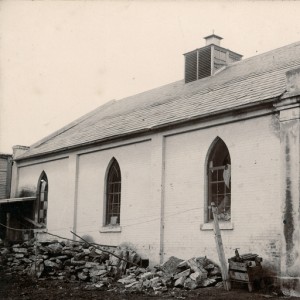
Young opens his school in the Ebenezer (Congregationalist) chapel in 1852. (Photo from 1908.) State Library of South Australia
From early in the colony’s history, private and church-sponsored schools, usually short-lived, sought enrolments from families of dissenters. There were numerous schools that concentrated on elementary education. The demand for post-elementary education was uncertain. Nevertheless, within three years of arriving in 1837, Congregationalist pastor, Thomas Stow, established a ‘classical academy’. He was ‘always ready to promote moral, social and intellectual progress’, as were many influential dissenters in the colony. This academy, as with other very early post-elementary schools did not last long.
The most promising though ephemeral foundation providing principally for the boys of dissenting families was the South Australian High School, opened in 1850, partly in reaction to the foundation of the Church of England’s St Peter’s Collegiate School in 1847. St Peter’s attracted enrolments from several dissenter families, but criticism that its curriculum and religious culture were too sectarian, unattractive to dissenting families, quickly followed. The published objects of the College were clear enough. The school would attempt a colonial version of a Church of England public (grammar) school, including the teaching of the ‘Holy scriptures in the original tongues’, principles of the Christian religion, classics and mathematics, together with other subjects that might ‘constitute a sound and liberal education’. The ‘religious worship and teaching [was] in accord with the formularies and liturgies of the Church of England’. (Quoted in Pike, p. 489.)
Dissenters quickly realized that they required their own post-elementary schools or academies, this being especially urgent following the collapse of the South Australian High School when its headmaster and teachers left the colony for the Victorian goldfields in 1851.
Although this entry concentrates on the academy led by John Lorenzo Young, in South Australia there were other academies of substance, including the Hahndorf Academy (1857-1877). Its founder, T. Wilhelm Boehm offered ‘a sound and good English and German Education’. The fate of the Hahndorf Academy was not unusual. Though it had served many Lutheran families from its beginning, it became a Lutheran collegiate school in 1877 when bought by the Church. That school was forced to close when a new state high school started up in a nearby town in 1912.
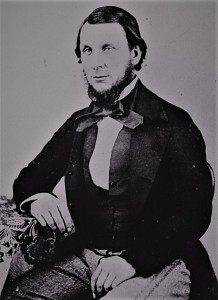
John Lorenz Young, the headmaster, 1861. B3445, State Library of South Australia.
John Lorenzo Young opens the Adelaide Educational Institution
John Lorenzo Young (1826-1881) had been an assistant teacher at the South Australian High School, leaving the colony with his fellow teachers for the gold rush. He soon returned, opening his own school in 1852, the Adelaide Educational Institution in the Congregationalist Ebenezer Chapel. The school grew over time, shifting several times to different parts of the city, and finally in 1872, to a purpose-built school in a close by Adelaide suburb, Parkside.
The school began with 15 boys (1852), reaching a peak of 124 (1854), thereafter fluctuating between 79 and 95 between 1855 and 1859. Enrolment records are not complete. There were likely more students enrolled than are now able to be counted. Known enrolments over the life of the school (1852-1880) are some 1,630 boys.
Lorenzo Young was uniquely prepared for the establishment of a successful academy that might serve the advanced educational needs of wealthier dissenting families. His Congregationalist affiliation was one element. His father, in England, had been a successful building contractor who was able to provide Lorenzo with a substantial education, some of which occurred outside of England.
In France he undertook a technical and vocationally oriented education in Boulogne. From there he went on to study in Nassau (Germany). The teaching experienced from the liberal Lutheran professor, Dr Opel was particularly influential for the future. Opel offered a science-based curriculum and progressive teaching methods. On his return to London, at age 16, Lorenzo was briefly enrolled in the College of Civil Engineers, but then, Kings College, in the Department of Engineering, Architecture, Arts and Manufactures. He received a modern education that was simply unavailable in Oxford or Cambridge. Kings College, later to join the University of London, was an Anglican foundation, but welcomed non-conformists (including dissenters, both students and professors). Then, after working briefly on the railways in Cornwall, Young emigrated at age 24, arriving in South Australia in 1850.
Young’s educational background, along with his youth and energy, positioned him well not only to offer the sons of colonists a distinctively modern and ‘useful’ education, but to contribute more broadly to the intellectual life of the colony through newly founded societies such as the Adelaide Philosophical Society.
The Adelaide Educational Institution was opened in 1852. It lasted some 29 years, closing in 1880. For private academies in the Australian colonies, such longevity was unusual. It was also unusual that it closed on the decision of its proprietor headmaster, rather than as a consequence of some personal or broader disaster.
Organisation of the school
As were most private schools in the nineteenth century, the school was family run. Lorenzo Young’s brother, Oliver, had substantial organizational and teaching responsibilities. Undoubtedly Young’s wife took responsibility for students boarding at the school. They were taken into his home. These were a minority in comparison with other of his students living in private boarding houses usually close to the school in central Adelaide. Young noted the wishes of parents concerning the studies of their boys. Private schools in the nineteenth century that failed to meet parent requests tended not to last long.
Students ranged in age from 7 to 17 years. Young organized his school into three classes, First, Second and Third (see table below). He took responsibility for teaching the most advanced (graduating) class of older boys, the First Class. As can be seen, the age of the student was less important than a judgement about readiness for the difficulty of subjects being offered. Students generally attended the school for three to four years.
Table: Schoolroom organisation of Adelaide Educational Institution.
| School classes | Age of students (years) |
| First class | 12 to 17 |
| Second class | 11 to 14 |
| Third class | 7 to 11 |
| Special classes for music and languages |
Source: Chessell (2014), p. 65
Games were encouraged, and AEI teams, especially cricket teams, played against those of St Peter’s College, and later the Prince Alfred College.
Curriculum, teaching, testing and reporting
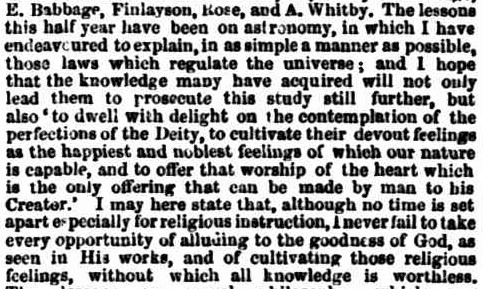
Part of Young’s report to the school community in 1858, in which he talks science and religion. Source: Adelaide Observer, 18 December 1858.
Evidence of the teaching style suggests that Young relied little on textbook oriented rote learning. Young lectured students, and they were expected to answer questions on content the following day. Note taking and the writing of essays was required. Student discussion, observation and a degree of freedom in choosing subjects to study was the approach. Mapping, surveying and charting were encouraged. The progressive Lutheran schooling Young had experienced in Germany was a major influence on his pedagogy.
From time to time, excursions into the surrounding countryside occurred. Students developed their observational skills, experiencing the applied and practical nature of their education in the ‘real world’.
Corporal punishment as an incentive for attentive learning was mainly absent. Formal religious instruction was necessarily minimal, though the school was hardly irreligious (see newspaper extract from 1858 on this page). It is likely that other teachers followed similar patterns of instruction although textbooks in mathematics and languages other than English would certainly have had a role to play.
As far as can be discerned, Young insisted on employing well-educated teachers. He did not employ monitor or pupil teachers in training. Clergy were little in evidence except where unavoidable, perhaps in teaching Latin. A number of the teachers of optional subjects, such as Charles Hill, artist and art teacher, taught in more than one school. Employment of such peripatetic (travelling) specialist teachers lasted for some years into the twentieth century in secondary schools. In keeping with his version of a dissenting academy, Young and his fellow teachers did not wear academic gowns. This was a tradition that marked the school out from church collegiate grammar schools.
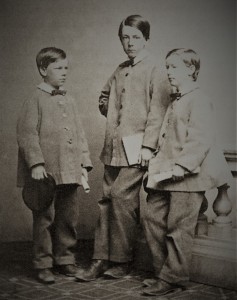
Three boys from the Adamson family. Around 1864, and probably on the day of the public examination. Source: Chessell, 2014, from B. Evans, From Weavers to Wapstraws, Adelaide, 1993. .
At this time, examinations of students were public affairs. They were held in suitable spaces such as the Freeman Street Congregational Chapel or suitable assembly rooms. One alumnus recalled the procedure:
It was a great day for the boys … On one side of the room … a sort of wooded hoarding … covered with scarlet cloth was placed, and here were tacked the maps, the drawings mechanical and freehand, the large plans of the surveying students … Architectural drawings of some of the large city buildings were also shown, one of which was the Pepperbox Ecclesiastical erection of the Congregational church in Hindmarsh Square. (Verco, 1963, quoted in Chessell, 2014)
Such displays are evidence of the role that surveying, architecture, engineering and applied science, along with school excursions (field studies) played in the curriculum. The Torrens River valley and Adelaide Hills provided sites for field studies.
The school’s public examinations, the prize-winners, and speech of the headmaster were reported in the newspapers of the day. Examinations were held twice yearly. Monthly progress reports on individual students were also issued to parents. In keeping with the progressive ideas of Young, the most significant prize awarded any student was for ‘industry’, rather than a direct rewarding of the student with the highest marks.
Subjects offered to students varied over the years as student/parent demand fluctuated, as the strengths and interests of teachers were taken into account, and as the enrolment numbers allowed fewer or greater numbers of subjects to be taught. In listing the subjects taught, some have changed their character and names over the last century and more.
Nearly all students studied English (with an honoured place for poetry), mathematics, history, geography and natural philosophy (physics). Other subjects might include chemistry, mechanical and freehand drawing, surveying, political economy, physiology, geology and languages. Latin and Greek (classical) appeared to be options offered under sufferance (they were the languages valued by established churches, Catholic and Anglican–not so much the dissenters). French and German were also available. Events such as the arrival of railways in the colony became a prompt for engineering studies. In 1857 boys in the First Class, along with their usual subjects, were examined on the workings of printing presses, locomotives and paper-making machines.
Students and their families
A comprehensive list of students of the school has been compiled by Chessell (2014). The families who supported the school were chiefly those of dissenters, especially Congregationalist and Wesleyans of different kinds. Many were among the leading, wealthier families of the colony. Some fathers were members of the Legislative Council. Some students became politicians, civic and business leaders. Alumni included two premiers of South Australia and four Lord Mayors of Adelaide. For a significant period, the school was larger than and at least equal in status to the Church of England’s, St Peter’s College.
School fees were substantial, as was required to sustain a high quality teaching staff, and to pay rents for school buildings. In 1859 the annual fee per boy was 10 guineas (£10/10). Such a fee was well beyond the incomes of most South Australian colonists. At the same time it needs to be remembered that post-elementary schooling in much of the nineteenth century was principally for middle and ruling class boys, considered quite unsuitable for working class boys, and most girls.
The end of the school
In the 1860s, Wesleyan Methodists sought to develop their own school. The opening of the Prince Alfred College in 1869 affected the enrolments of the Adelaide Educational Institution. Nevertheless, the two schools saw themselves as associated, competing against one another in sports, and sharing teaching staff for a time. When the AEI eventually closed, many of its students transferred to the Prince Alfred College (PAC). The curriculum offered boys at PAC included emphases pioneered by Young, including sciences, and subjects that were vocationally useful.
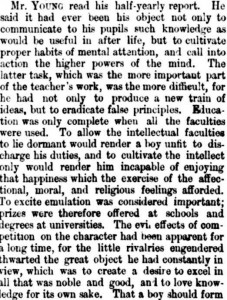
The importance of developing the intellect, according to Lorenzo Young. From another school report, 1871. Source: SA Register, 17 June 1871.
Like St Peter’s College, Prince Alfred’s increasingly aspired to the new Arnoldian culture of boys’ collegiate and grammar schooling. Prefects, school uniforms, houses, school magazines, a highly developed corporate culture and more were a step beyond the cultural and boy-forming educational aspirations of the Adelaide Educational Institution. The kind of schooling offered by Lorenzo Young, practised by remaining dissenting academies in England and the British Empire, privately owned or otherwise, was in its twilight.
The Adelaide Educational Institution closed in 1880. The location of the school, the sixth and last, despite its purpose-built facilities in Parkside was outside the city centre. This was a disincentive to enrolment for some families, although the centre of the city was becoming less attractive with the rise of larrikin gangs. Parkside, unlike the eastern suburban sites of St Peter’s and Prince Alfred colleges, did not develop a strong middle class character.
Reduced enrolments meant that preparing students for university matriculation may have been more difficult. A tradition of preparing students for the University of Melbourne before the local university opened in 1874 began to falter. Students in the last few years began transferring to Prince Alfred College, especially if they were interested in university matriculation. The importance of Latin and Greek as school subjects increased as the universities developed their grip over secondary school curricula. This was a problem for the independent and progressive curricula advocated by Young and the Adelaide Educational Institution.
With fewer enrolments, and the expense of the purpose built school that jeopardized the financial viability of the school, Young chose to close it.
The contribution of the school
Even though Lorenzo Young’s dissenting academy shared the fate of other private post-elementary schools in the late nineteenth and early twentieth century, closing as the larger, better funded church collegiate schools developed, it had made a considerable impact on the colony of South Australia.
It had educated many boys of the emerging middle and ruling classes, providing families with a school that did not offend their dissenting and non-conformist religious beliefs. Young had provided a model of a progressive post-elementary curriculum, firmly based on a belief that science, industry and vocational relevance should form a substantial part of a boy’s schooling. The teaching method was progressive for its time. Young was a firm critic of prevailing methods and curriculum that elevated rote-learning and text-book study above all else. He wanted boys to reason and observe their way towards a substantial education.
The school provided an advanced education for boys. There was no local university for most of the school’s life. Neither the School of Mines and Industry nor the Roseworthy Agricultural College were opened until the 1880s. The best place for a progressive, modern, and science-respecting higher education in Adelaide in the 1850s through the 1870s was John Lorenzo Young’s school. In this period, several of the professions, including surveying, architecture and law were entered by young men under cadet schemes or articles. They learnt on the job. An education at the Adelaide Educational Institution ensured a head-start for many of the young men who sought this kind of employment. It did for young men what universities and the technical colleges would later do as they developed their professional degrees, certificates and diplomas as preparation for professional and other careers.
